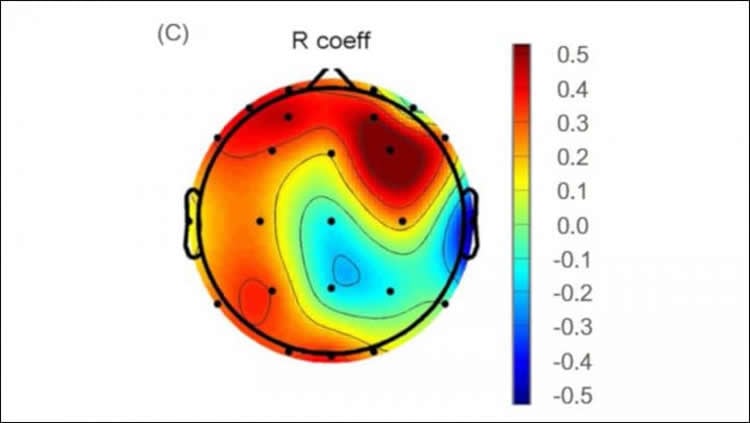Summary: People with greater frontal alpha asymmetry are less able to regulate strong, emotional, affective states, such as anger, in their dreams.
Source: SfN
Researchers have identified a pattern of brain activity that predicts anger experienced during dreaming, according to a new study of healthy adults published in Journal of Neuroscience. The research could potentially inform efforts to understand the neural basis of the emotional content of nightmares, a feature of various mental and sleep disorders.
Although emotions are experienced during both waking and dreaming, few studies have investigated the brain mechanisms underlying the affective component of dreams. Pilleriin Sikka and colleagues at University of Turku, University of Skövde, and University of Cambridge discovered a shared emotional mechanism between the two states of consciousness.
The researchers obtained electroencephalography recordings from participants during two separate nights in a sleep laboratory. After five-minute bouts of rapid eye movement (REM) sleep, participants were woken and asked to describe their dream and rate the emotions they experienced in the dream.

Individuals who displayed greater alpha-band brain activity in the right, as compared to the left, frontal cortex during evening wakefulness and during REM sleep experienced more anger in dreams.
This neural signature – called frontal alpha asymmetry (FAA) – has been linked to anger and self-regulation during wakefulness.
Together, these results suggest FAA may reflect a universal indicator of emotion regulation.
Source:
SfN
Media Contacts:
David Barnstone – SfN
Image Source:
The image is credited to Sikka et al., JNeurosci (2019).
Original Research: Closed access
“EEG Frontal Alpha Asymmetry and Dream Affect: Alpha Oscillations Over the Right Frontal Cortex During REM Sleep and Pre-Sleep Wakefulness Predict Anger in REM Sleep Dreams”
Pilleriin Sikka, Antti Revonsuo, Valdas Noreika and Katja Valli. Journal of Neuroscience. Published online April 15, 2019 doi:10.1523/JNEUROSCI.2884-18.2019
Abstract
EEG Frontal Alpha Asymmetry and Dream Affect: Alpha Oscillations Over the Right Frontal Cortex During REM Sleep and Pre-Sleep Wakefulness Predict Anger in REM Sleep Dreams
Affective experiences are central not only to our waking life but also to rapid eye movement (REM) sleep dreams. Despite our increasing understanding of the neural correlates of dreaming, we know little about the neural correlates of dream affect. Frontal alpha asymmetry (FAA) is considered a marker of affective states and traits as well as affect regulation in the waking state. Here, we explored whether FAA during REM sleep and during evening resting wakefulness is related to affective experiences in REM sleep dreams. Electroencephalography (EEG) recordings were obtained from seventeen human participants (7 men) who spent two nights in the sleep laboratory. Participants were awakened five minutes after the onset of every REM stage after which they provided a dream report and rated their dream affect. Two-minute pre-awakening EEG segments were analyzed. Additionally, eight minutes of evening pre-sleep and morning post-sleep EEG were recorded during resting wakefulness. Mean spectral power in the alpha band (8-13 Hz) and corresponding FAA were calculated over the frontal (F4-F3) sites. Results showed that FAA during REM sleep, and during evening resting wakefulness, predicted ratings of dream Anger. This suggests that individuals with greater alpha power in the right frontal hemisphere may be less able to regulate (i.e., inhibit) strong affective states, such as Anger, in dreams. Additionally, FAA was positively correlated across wakefulness and REM sleep. Together, these findings imply that FAA may serve as a neural correlate of affect regulation not only in the waking but also in the dreaming state.
SIGNIFICANCE STATEMENT
We experience emotions not only during wakefulness but also during dreaming. Despite our increasing understanding of the neural correlates of dreaming, we know little about the neural correlates of dream emotions. Here we used electroencephalography to explore how frontal alpha asymmetry (FAA)—the relative difference in alpha power between the right and left frontal cortical areas that is associated with emotional processing and emotion regulation in wakefulness—is related to dream emotions. We show that individuals with greater FAA (i.e., greater right-sided alpha power) during rapid eye movement (REM) sleep, and during evening wakefulness, experience more anger in dreams. FAA may thus reflect the ability to regulate emotions not only in the waking but also in the dreaming state.







